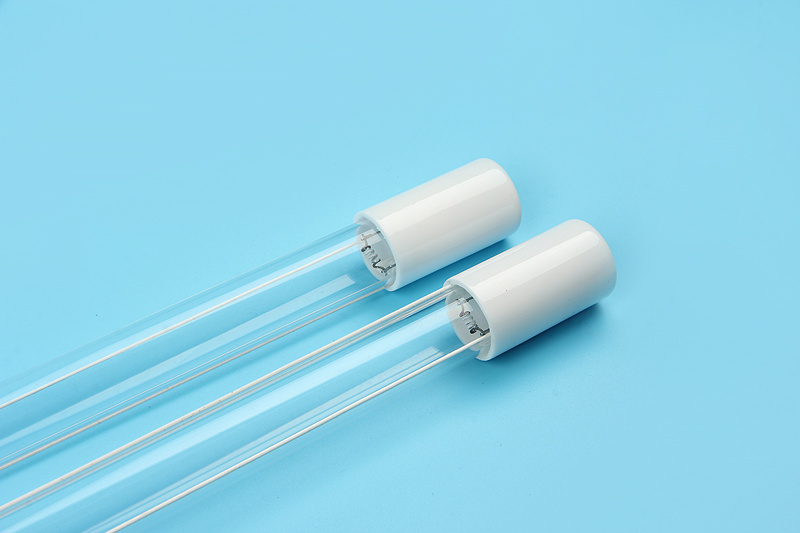1. Ultraviolet sterilization lamp(UV lamp) principle
The ultraviolet sterilization is to destroy and change the DNA (deoxyribonucleic acid) structure of the microorganism by the irradiation of the ultraviolet ray, so that the bacteria can be immediately killed or the offspring can not be propagated, and the purpose of sterilization is achieved. The true bactericidal effect is UVC ultraviolet, because the C-band ultraviolet is very easy to be absorbed by the DNA of the organism, especially about 253.7 nm of the ultraviolet ray is the best.
There are two main luminous lines of ultraviolet sterilizing lamp: 254nm and 185nm. 254 nm ultraviolet rays kill bacteria by irradiating the DNA of microorganisms. 185nm ultraviolet rays can change O2 into O3 (ozone) in the air. Ozone has strong oxidation effect and can kill bacteria effectively. The dispersion of ozone can make up for the fact that ultraviolet radiation only spreads in a straight line and disinfection has dead angle.
Ultraviolet sterilization is a pure physical disinfection method, which has the advantages of simple and convenient, broad-spectrum and efficient, no secondary pollution, convenient management and automation. With the introduction of various new designs of ultraviolet lamp, the application range of ultraviolet sterilization is expanding.

2. Structure of UV Sterilization Lamp
UV sterilization lamp (UV lamp) is actually belongs to a low pressure mercury lamp, like ordinary fluorescent lamp, using low pressure mercury vapor (<10-2Pa) to emit UV after being excited. The difference is that the fluorescent lamp tube is ordinary glass,254nm ultraviolet light cannot be penetrated, can only be absorbed by the inner wall of the lamp tube phosphor after the excitation of visible light. If you change the composition and proportion of the phosphor, it can emit light of different colors that we usually see. ...> General germicidal lamp tubes are made of quartz glass. The best material for the bacterial lamp.
The sterilizing lamp has several structures, such as hot cathode low pressure mercury vapor discharge lamp, cold cathode low pressure mercury vapor discharge lamp and so on, which can be divided into many types according to the appearance and power.
Quartz glass and ordinary glass in the performance of a great difference, mainly the coefficient of thermal expansion is different, generally cannot seal the aluminum cover lamp head, so sterilization lamp head material more use Bakelite, plastic or ceramic.

3. Lamp tube of ultraviolet germicidal lamp
Because the cost relation is different from the application, the high-borax glass tube with the ultraviolet penetration rate of less than 50% is also used instead of the quartz glass. The production process of the high-boron glass is the same as the energy-saving lamp, so the cost is low, but it is far from the quartz sterilization lamp in performance, and the sterilization effect of the high-boron glass is quite different.
The ultraviolet intensity of the high-boron lamp tube is easy to be attenuated, and the ultraviolet intensity after the lighting for hundreds of hours is greatly reduced to 50-70 percent of the initial time. And when the quartz lamp tube is ignited for 2000-3000 hours, the ultraviolet intensity is only reduced to 80-70 percent of the initial time, and the light attenuation degree is much lower than that of the high-boron lamp.
The invention also relates to a common glass with high ultraviolet light transmittance, which is much higher than that of the high-boron glass and is slightly lower than that of the quartz glass. But the light decay is greater than the quartz germicidal lamp and does not produce ozone. A lamp on a germicidal lamp produced by Philip is made of this type of glass.

4. Types of ultraviolet sterilizing lamps
There are two main luminous lines of ultraviolet sterilizing lamp: 254nm and 185nm. 254 nm ultraviolet rays kill bacteria by irradiating the DNA of microorganisms. 185nm ultraviolet rays can change O2 into O3 (ozone) in the air. Ozone has strong oxidation effect and can kill bacteria effectively. The dispersion of ozone can make up for the fact that ultraviolet radiation only spreads in a straight line and disinfection has dead angle.
When quartz glass is refined, if a sufficient amount of titanium (Ti) element is added, the ultraviolet light passing through it can be cut off below 200nm, but has little effect on the ultraviolet transmission of 254nm. The escape of 185nm ultraviolet can be effectively controlled by properly controlling the amount of titanium added. According to this characteristic, we can make three kinds of ultraviolet sterilization lamp, such as low ozone (no ozone), ozone, high ozone and so on.


